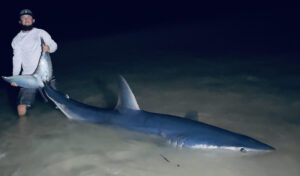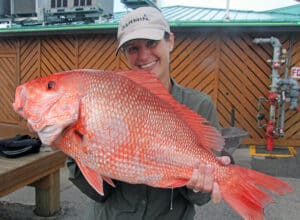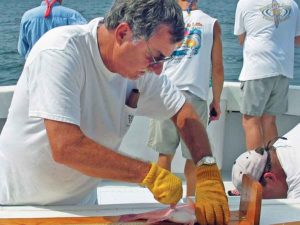In all of angling, not many experiences compare to seeing a monstrous tarpon catapult through a cloudless blue sky. Except, that is, perhaps hearing one explode in the darkness of night. Tarpon fishing in Miami is great fishing, but doing it at night is truly a unique experience.
Welcome to Miami, home of palm trees, high fashion and nighttime tarpon fishing. Over the years, hundreds of thousands of poons have been landed after dark around this bustling metropolis. And while much of the city’s after-hours tarpon bite occurs in the bumpy waters of inlets and along beaches, another game is played within the calmer confines of Biscayne Bay.
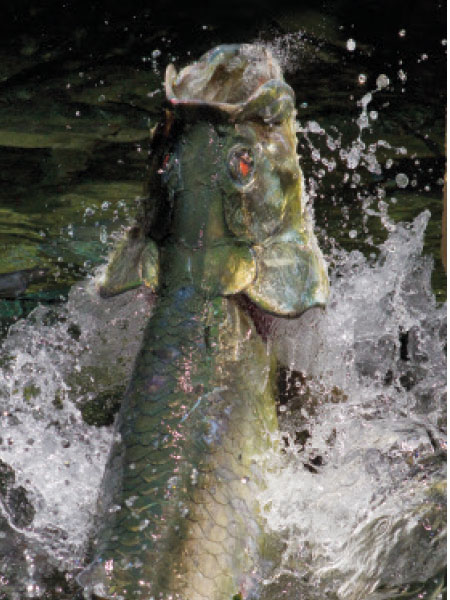
It’s on the bay, surrounded by twinkling city lights, that you’ll find Capt. Bob LeMay (954-435-5666; lemaymiami@aol.com) hard at work. For 40 years, LeMay has been plying the bridges of Biscayne Bay in search of catching tarpon.
But LeMay isn’t fishing for monsters. Instead, he targets juvenile tarpon with light spinning gear and fly tackle. These fish gather at bridges and docks, gorging on shrimp that are swept on outgoing tides through the bay toward the Atlantic.
“As the shrimp approach the bridges,” explains LeMay, “they rise in the water column because of the street lights. The tarpon hang out in the shadows, facing into the current. When the shrimp cross into the shadow line, the fish rise and take.”
Biscayne Bay hosts two shrimp runs each year. The first generally starts in January or February and peaks in March and April. The tarpon feasting on these shrimp around bridges generally run 20 to 40 pounds.
The second fishery occurs June through mid-August. These fish are smaller, typically 10 to 30 pounds. But all are fine sport on the light gear LeMay employs. He uses 10-pound spinning outfits with 40-pound leaders, and either live shrimp on 1/0 hooks or ¼-ounce DOA shrimp in clear with gold glitter.
How does he get away with such light gear around so much concrete and steel?
Simple — LeMay stays agile. He positions skiff and angler into ideal sight-casting range by literally holding onto the pilings. When a fish is hooked, he quickly pushes off, fires up the engine and chases down the fish. It’s an efficient and effective routine, and a good night (typically around five hours) of tarpon fishing in Miami can generate a dozen or so spectacular strikes.
Still, it’s not always easy once a fish is hooked. “Even the little ones can be a handful,” LeMay laughs.
No doubt every tarpon is a handful. But not far from where these small fish keep LeMay’s anglers busy, larger tarpon lie in wait. Much larger tarpon.
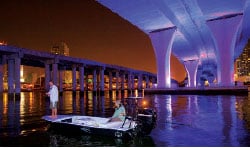
| |Small tarpon lie in wait at nighttime in the shadow lines of Biscayne Bay bridges. Drifting live shrimp and DOAs can be deadly. (Adrian E. Gray)|
It’s in these dark places, far from the ripping currents and bright lights of the bridges that Capt. Russell Kleppinger (786‑290‑3474; captruss1@bellsouth.net) drifts for tarpon that can weigh up to 200-plus pounds.
“It’s the old bull and the young bull story,” he says. “The young ones are aggressively feeding on the shadow lines around the bridges, but the big fish lie back in the lighter currents of open water, gently slurping up the food before it gets back to where the kids are playing.”
Kleppinger targets these whoppers — which average 80 to 120 pounds — in September and October during the annual mullet run, and then again from April through June. He works 20 or so spots within the bay and focuses on a half-dozen honey holes, all of which produce during different tidal stages.
Like LeMay, Kleppinger generally prefers an outgoing tide (especially during the warmer months), as it pulls dirty water out of the bay and relaxes the tarpon. He also opts for live shrimp and crabs, but notes that flies can be particularly effective.
Because of the size of these fish, however, Kleppinger beefs up the gear. He goes with spinning outfits filled with 30-pound braid for smaller fish and increases to 50-pound when monsters are around. He uses 10 to 12 feet of 60-pound Momoi fluoro leader with 7/0 or 8/0 circle hooks, and he drifts his spots with the current, working the trolling motor when needed.
Kleppinger believes tarpon segregate themselves by weight class — and focusing on these bigger fish has netted him, at press time, four tarpon so far this year estimated at between 180 and 200 pounds.
But like LeMay, he says that successful night fishing for tarpon of any size is all about subtleties, and Kleppinger avoids using spreader lights, and is extremely cautious of keeping some distance between his boat and the fish.
“Little tweaks can make you better than the average bear,” he says.

